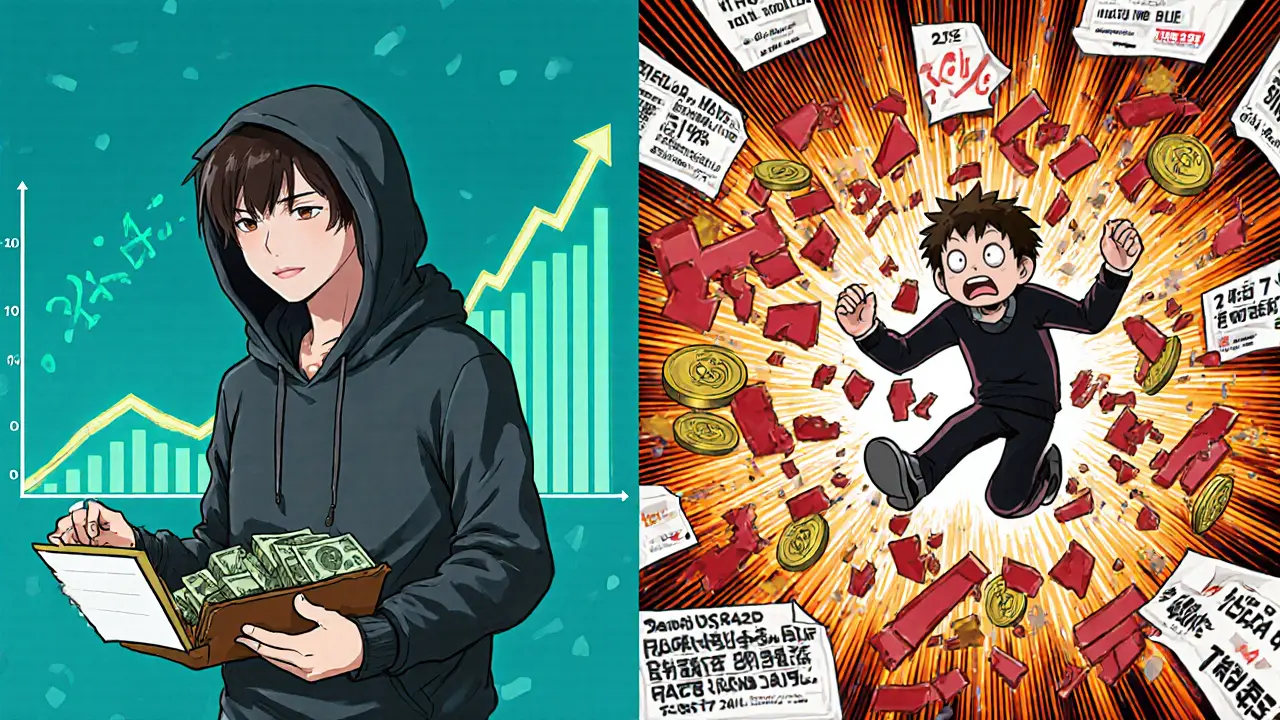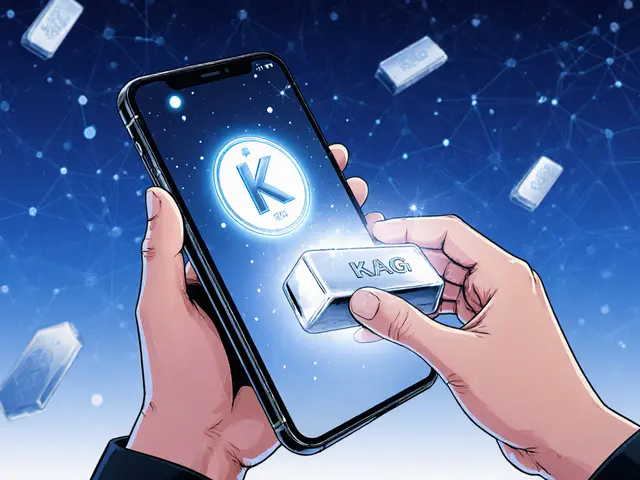Crypto Margin Trading Calculator
Margin Trading Calculator
Results
Important: This is a simulation only. Real-world margin trading carries significant risk of losing more than your initial investment.
What Is Margin Trading in Crypto?
Margin trading lets you borrow money from a crypto exchange to buy more coins than your balance allows. If you have $1,000, you might borrow another $1,000 to trade $2,000 worth of Bitcoin. This is called leverage. Most exchanges offer 2x, 5x, or even 10x leverage. That means your $1,000 can control $10,000 in assets. It sounds powerful-and it is. But it’s not magic. Every gain gets multiplied, and so does every loss.
Unlike traditional stocks, crypto markets never close. Prices swing wildly in minutes. A 5% drop in Bitcoin could wipe out your entire stake if you’re trading at 10x leverage. That’s why margin trading isn’t for beginners. It’s for traders who understand how price action, liquidation, and interest work together.
The Big Reward: Amplified Profits
Let’s say you believe Ethereum will rise from $3,000 to $3,600. With $1,000 cash, you buy 0.33 ETH. If it hits $3,600, you make $180 profit-18% return. Now, use 5x leverage. You borrow $4,000, buy 1.33 ETH, and when it hits $3,600, your position is worth $4,800. You pay back the $4,000 loan, and you’re left with $800. Your profit? $800. That’s an 80% return on your original $1,000.
This is the hook. Margin trading turns small moves into big wins. In a bull market, it’s how some traders turn $5,000 into $50,000 in months. Exchanges like Binance, Bybit, and Kraken make it easy. One click, and you’re trading with borrowed funds. No bank forms. No waiting days for settlement. You get instant buying power.
The Hidden Cost: Interest and Fees
But you don’t get free money. Every hour you hold a margin position, you pay interest. Rates vary by exchange and coin. On Binance, BTC margin interest can range from 0.01% to 0.05% daily. That’s 3.65% to 18.25% annually. Sounds low? Multiply that by $10,000 borrowed. That’s $1 to $5 per day. Over 30 days, that’s $30 to $150-just for holding.
And if you hold for weeks? Interest piles up. Some traders forget this. They focus on the price move, not the cost of borrowing. In a sideways market, you can lose money even if the coin doesn’t drop-because interest eats your profits. One trader I know held a long BTC position for six weeks. The price stayed flat. He lost $1,200 in interest. His trade broke even. He didn’t make a cent.

The Real Danger: Liquidation
Here’s where most people lose everything. Every margin trade has a liquidation price. That’s the price at which the exchange automatically sells your assets to cover the loan. If you trade ETH at 5x leverage with a $1,000 deposit, your liquidation price might be $2,700-even if ETH is trading at $3,000. A 10% drop kills your position.
And it happens fast. Crypto drops of 20% in an hour aren’t rare. In May 2022, TerraUSD collapsed. Within 48 hours, $40 billion in crypto value vanished. Thousands of margin traders got liquidated. Some lost their entire accounts. Others owed money to the exchange.
That’s right. You can owe more than you put in. If your position liquidates and the market keeps falling, the exchange may still need to recover the full loan amount. They’ll send you a bill. I’ve seen Reddit threads where people describe taking second jobs to pay back $50,000 in margin debt.
Margin Calls: The Silent Killer
Before liquidation, you might get a margin call. That’s a warning: your equity is too low. You need to deposit more funds or close part of your position. If you don’t act, the exchange closes it for you.
But here’s the problem: in fast markets, you might not even see the call. The price drops 15% in 90 seconds. Your phone dies. Your internet glitches. By the time you log in, your position is gone-and you’re still on the hook for the loan.
Exchanges don’t care about your excuses. They’re not banks. They’re platforms. Their job is to protect themselves. If you’re under-margined, they’ll liquidate you without warning. No second chances.
Who Should Use Margin Trading?
Not you-if you’re new. Not you-if you’re trading with money you can’t afford to lose. Not you-if you don’t track your positions hourly.
Margin trading is for experienced traders who:
- Understand technical analysis and price action
- Have a strict risk plan (never risk more than 2% per trade)
- Use stop-losses and set personal liquidation triggers well above the exchange’s minimum
- Keep cash reserves to cover interest and margin calls
- Only trade assets with high liquidity (BTC, ETH, SOL-not random altcoins)
Even then, most successful traders use low leverage-2x or 3x. They don’t chase 10x. They win slowly, consistently. They know that surviving the next crash matters more than winning one big trade.

How to Stay Safe
If you’re going to trade on margin, here’s how to avoid becoming a cautionary tale:
- Start with 2x leverage. Never go above 5x until you’ve traded for at least a year.
- Always keep 50% of your account in cash. That’s your buffer.
- Set your own liquidation trigger 15-20% above the exchange’s minimum. Don’t wait for their warning.
- Pay interest weekly. Don’t let it compound.
- Never use margin to average down a losing position. That’s how people lose everything.
- Turn off auto-reborrow. Some exchanges let you borrow again after liquidation. That’s a trap.
One trader I follow uses a simple rule: if a trade can’t make 3x the interest cost in 48 hours, he doesn’t take it. That keeps him focused on high-probability moves-not gambling.
Margin Trading vs. Spot Trading
Spot trading means buying crypto with your own money. No borrowing. No interest. No liquidation risk. You buy Bitcoin at $60,000. You hold. It drops to $50,000. You lose $10,000. But you still own the Bitcoin. You can wait for it to recover.
With margin, if it drops to $50,000 and you’re at 5x leverage, you’re liquidated. You lose everything. No second chance. No waiting. Just gone.
Spot trading is for long-term investors. Margin trading is for short-term traders who know exactly what they’re doing-and are ready to lose.
The Bottom Line
Margin trading in crypto isn’t a get-rich-quick scheme. It’s a high-speed, high-stakes game. The rewards are real. The risks are brutal. Most people who try it lose money. Those who win? They treat it like surgery-not a lottery.
If you’re thinking about trying it, start small. Paper trade first. Learn how liquidation works. Watch how interest eats into profits. Read the fine print on your exchange’s margin terms. And never, ever risk money you can’t afford to lose.
Because in crypto, the market doesn’t care how smart you are. It only cares if you’re prepared.
Can you lose more than you invest in crypto margin trading?
Yes. If your position is liquidated and the market continues dropping, the exchange may still need to recover the full loan amount. In extreme cases, you can end up owing money to the exchange. This is why some traders have to take second jobs to pay back margin debt.
What’s the minimum amount needed to start margin trading?
Most exchanges require a minimum of $100 to $500 to open a margin account. However, to trade safely, you should start with at least $1,000. Lower balances leave you vulnerable to liquidation from small price swings.
How do margin interest rates work in crypto?
Interest is charged daily, often hourly, on the borrowed amount. Rates vary by coin and exchange-typically between 0.01% and 0.05% per day. For a $5,000 loan, that’s $0.50 to $2.50 per day. Over time, this adds up, especially if you hold positions for weeks.
Is margin trading legal in New Zealand?
Yes. Margin trading is legal in New Zealand, but exchanges operating here must comply with local financial regulations. The Financial Markets Authority (FMA) requires clear risk disclosures. However, there’s no licensing requirement for users, so the responsibility falls entirely on the trader to understand the risks.
Which crypto assets are safest for margin trading?
Stick to high-liquidity coins: Bitcoin (BTC), Ethereum (ETH), and Solana (SOL). These have tight bid-ask spreads and are less likely to experience sudden, extreme price gaps. Avoid low-cap altcoins-they’re more volatile and harder to exit quickly during a margin call.
Can you avoid margin calls?
You can reduce the chance by keeping extra cash in your account, using lower leverage, and setting personal stop-losses well before the exchange’s liquidation price. Never trade without a plan. Margin calls happen fast-being prepared is the only way to survive them.







Brett Benton
November 1, 2025 AT 09:08Beth Devine
November 1, 2025 AT 12:27alvin Bachtiar
November 2, 2025 AT 13:44Eric Redman
November 3, 2025 AT 04:30Josh Serum
November 3, 2025 AT 13:45David Roberts
November 5, 2025 AT 12:47Jessica Hulst
November 6, 2025 AT 06:05Jason Coe
November 8, 2025 AT 03:23Genevieve Rachal
November 8, 2025 AT 10:49Elizabeth Melendez
November 8, 2025 AT 19:11Hanna Kruizinga
November 9, 2025 AT 21:27Brian McElfresh
November 10, 2025 AT 02:56Kaela Coren
November 10, 2025 AT 11:09Helen Hardman
November 11, 2025 AT 22:48Phyllis Nordquist
November 12, 2025 AT 23:53David James
November 14, 2025 AT 22:08Nabil ben Salah Nasri
November 15, 2025 AT 03:18Shaunn Graves
November 16, 2025 AT 08:16Phil Higgins
November 17, 2025 AT 06:14Bhavna Suri
November 17, 2025 AT 19:45DeeDee Kallam
November 18, 2025 AT 04:46Eliane Karp Toledo
November 18, 2025 AT 20:22Monty Tran
November 20, 2025 AT 03:21